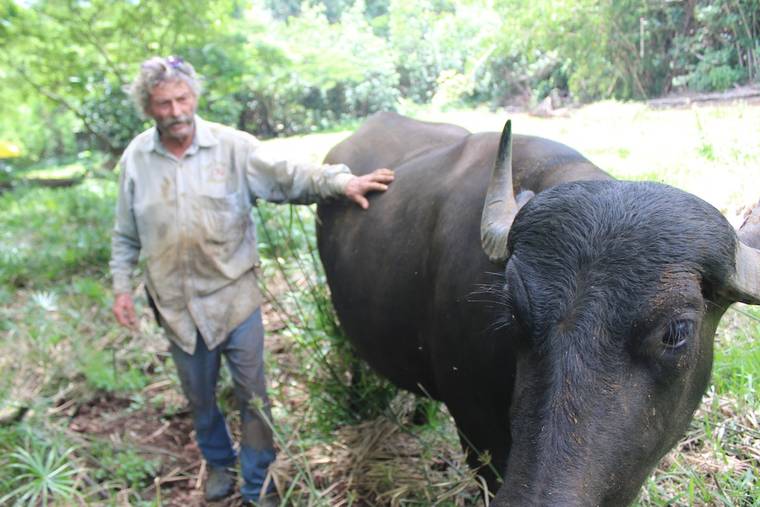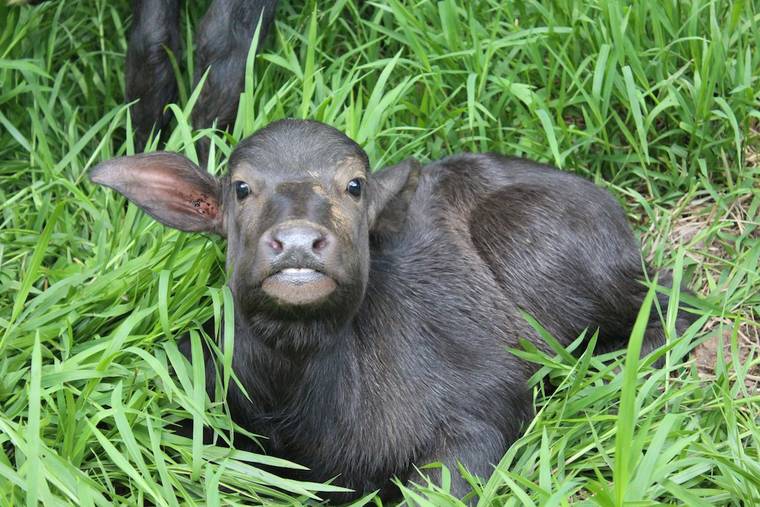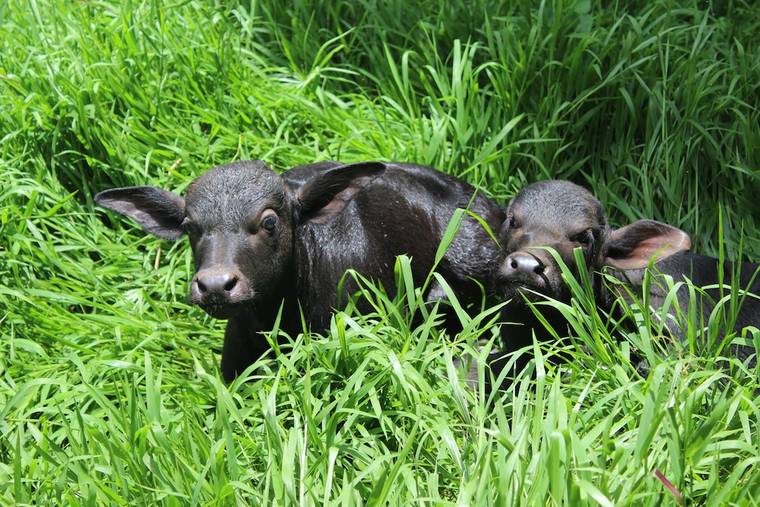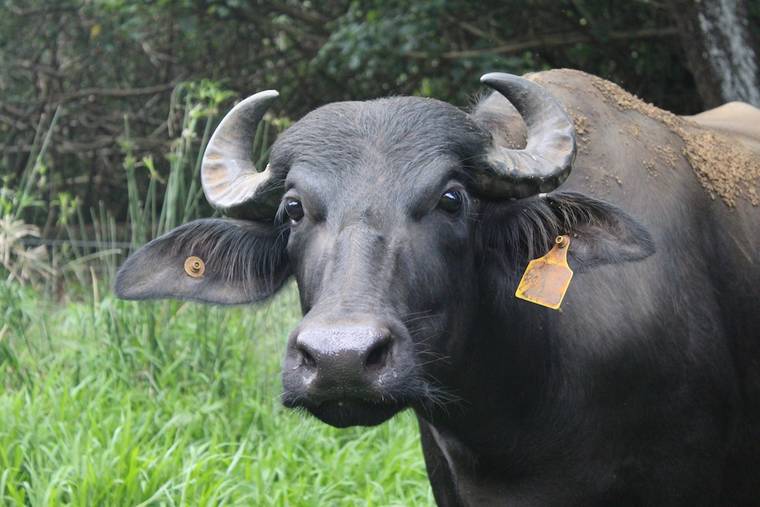Don Heacock is a lot of things. He’s just retired from 40 years as an aquatic biologist with the state Department of Land and Natural Resources. He’s an advocate for sustainable agriculture that cultivates things like yerba mate, awa and taro alongside tilapia aquaponic projects on his 25-acre Lihue farm, called Kauai Organic Agroecosystems.
It’s a long drive down a steep, dirt road to get to KOA Farm. A high, wooden bridge takes visitors out to the kalo, or taro, lo‘i, and to the food forest-style collection of avocado, rambutan, Thai longan, ulu, papaya, coconuts, macadamia nuts, banana — just to name a few.
Walk through the taro, past some fruit trees and habitats for Muscovy ducks and free-range chickens, and you’ll find Heacock’s new pride and joy, though: three, brand new water buffalo calves.
The new additions, which arrived the last week of August, bring his herd up to seven animals, including four female adult buffalo, the last of which is due in December.
Heacock worked for three years to change the state Department of Agriculture’s restricted animal list to allow the herd. It required hours of paperwork, dozens of meetings and some travel — but Heacock managed to bring the water buffalo to Hawaii from Arkansas, with the goal of increasing local food production and adding another tool to the box for battling invasive species.
The water buffalo were friendly and curious when TGI met with Heacock in the paddock at the very back of the property he leases from Grove Farm. Heacock walked right in the paddock with them, greeting them as his pets and praising their new calves.
“Last week, the heavens opened and the angels sang, and three little dairy water buffalo joined the world,” he said. “Kane is the little boy and then the two girls are Kala and Buffy.”
What was it like when the calves were born?
The two girls, they were born two days apart and then the little guy, Kane, he came later. The cows were bred before they came to the island. I wouldn’t have had it any other way. Last week I got $9,000 worth of buffalo, so I’m happy. These are from the top bulls that the breeder has.
Tell us what’s special about these dairy water buffalo?
There’s a big difference between buffalo and bison. Bison’s what you have in Hanalei. They were charging people during the April flood, you remember? Someone could have gotten killed. Those are dangerous animals.
Domestic water buffalo have been domesticated for 5,000 years. Bison have never been domesticated.
They’re super intelligent and strong. Kane, over there, I might have an intern come from Tillers International to train him how to wear a harness and hams. He’ll be a draft animal. He’ll pull a wagon of produce to the farmers’ market. From here to Lihue it’ll take 15 minutes.
You put these in with a herd of cows and they’ll immediately get the best shade, the food first, if you put Ipo (the name of the biggest of the four water buffalo) over there in a harness and hams and took a big draft oxen and put it on the other end, she’d drag the oxen all over the place. These animals are super, super strong. They’re ruminants, like cows, but it’ll eat stuff like the umbrella sedge that a cow wouldn’t think about eating. Just like cows, but way smarter.
What we’re learning now is that these gals can fix more carbon by moving them from paddock to paddock than anything. They’re eating photosynthetic plants, pooping on the ground enriching the soil and growing more grass. Taking carbon out of the air and turning it into grass. They love guinea grass. It’s their favorite.
I don’t have to feed them, there’s plenty of food there for them. One of the unique things that makes them different than dairy cattle, they don’t need supplemental feeding at all.
They’ll clear land for me. They’ll eat anything. I’ll use them to clear hau bush. They’d be good for clearing wetlands, too. They get in there, they eat the California grass, they eat everything, and then they wallow. Those wallows become water bird feeding habitats, they’ll fertilize them, the insects come. It’s a thriving ecosystem.
What are some reasons both water buffalo milk and meat are popular?
The milk is twice the protein of cow’s milk, it has 30% higher butter fat, and they can produce up to 37 liters of milk every day. It’s worth a minimum of $3 a liter.
You can make mozzarella di bufala, the white whale of the cheeses, with buffalo milk. The real gelato is made from water buffalo milk. You give dairy cow mozzarella to an old Italian man and he’ll tell you it tastes like soap.
The meat is excellent eating. It’s super low in cholesterol and high in protein. They don’t have inner-muscular fat the way cattle do. All their fat is subcutaneous, right under their skin. When you cook it you gotta put coconut oil in the pan or it’ll burn.
We import all of our milk right now to Hawaii, and Hawaii doesn’t allow the sale of raw milk, but I can do herd-share programs where people can buy a share of the herd. I’ll milk the cows and then they can come do whatever they want with the milk that came from the cows they own.
What’s your ideal herd size, and what’s the future for these water buffalo?
There is no such thing as ‘ideal,’ but the ideal herd size would be on every island and on different parts of the island, because shipping milk doesn’t make sense, and shipping cheese makes even less sense.
If you’re herd-building you gotta have females, and I’m getting off to a good start with the two female calves and a male calf. I can only hope Ipo (she’s due in December) has a female calf. Then I’ll have seven females and one male. I also have some frozen semen from Italy and I’ve got a doctor of veterinary medicine from UH that’s offered to do the AI (artificial insemination) when it’s time.
At two and a half years old, they can be bred. But usually they’re bred at around three years old. These buffalo cows are three and a half years old and they’ll continue to grow until they’re about seven. Ipo, she’s at 1,700 pounds now. She’ll get close to 1,800 pounds. I’m working with Grove Farm to get more land from them, should know about that in a week or so.
•••
Jessica Else, environment reporter, can be reached at 245-0452 or jelse@thegardenisland.com.









Love the water Buffalow and everything that the farm represents.
Fantastic endeavor
Don- If you can just link the water buffalo program with an abalone farm, I am all in. Yes, this is your buddy from HSU.
We will connect. send your email/phone#.
206-660-5398.
Al Giorgi.